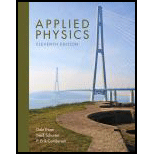
Applied Physics (11th Edition)
11th Edition
ISBN: 9780134159386
Author: Dale Ewen, Neill Schurter, Erik Gundersen
Publisher: PEARSON
expand_more
expand_more
format_list_bulleted
Concept explainers
Textbook Question
Chapter 11, Problem 9RQ
Explain how a satellite in orbit is in a constant state of free fall yet does not crash to the earth.
Expert Solution & Answer
Want to see the full answer?
Check out a sample textbook solution
Chapter 11 Solutions
Applied Physics (11th Edition)
Ch. 11.1 - Compare the gravitational force that (a) the earth...Ch. 11.1 - Find the gravitational force between the sun and...Ch. 11.1 - Find the gravitational force between the sun and...Ch. 11.1 - Find the gravitational force between the sun and...Ch. 11.1 - Find the gravitational force between the sun and...Ch. 11.1 - Explain why the gravitational force between the...Ch. 11.1 - A satellite is orbiting 3.22 105 m above the...Ch. 11.1 - If the satellite in Problem 7 is orbiting at twice...Ch. 11.1 - What is the gravitational force exerted between an...Ch. 11.1 - The Apollo 16 lunar module had a mass of 4240 kg....
Ch. 11.3 - The moon orbits 3.84 108 m from the earth. How...Ch. 11.3 - The moon orbits 3.84 108 m from the earth. How...Ch. 11.3 - Find the orbital velocity for Mercury as it orbits...Ch. 11.3 - Prob. 4PCh. 11.3 - Find the orbital velocity for Saturn as it orbits...Ch. 11.3 - Find the orbital velocity for Uranus as it orbits...Ch. 11.3 - Find the time Mercury takes to orbit the sun.Ch. 11.3 - Find the time the earth takes to orbit the sun.Ch. 11.3 - Find the time Saturn takes to orbit the sun.Ch. 11.3 - Find the time Uranus takes to orbit the sun.Ch. 11 - What type of force is related to the mass of...Ch. 11 - As the distance increases between two objects, the...Ch. 11 - As the mass of two objects increases, the...Ch. 11 - The mass of a satellite is increased. In order to...Ch. 11 - As the distance increases between a satellite and...Ch. 11 - Explain why the gravitational force that exists...Ch. 11 - What would happen to your weight on earth if the...Ch. 11 - What would happen to your weight on earth if the...Ch. 11 - Explain how a satellite in orbit is in a constant...Ch. 11 - According to Isaac Newton, how is the motion of a...Ch. 11 - Most planets actually have slightly elliptical...Ch. 11 - Does the mass of a satellite influence the time it...Ch. 11 - Two 0.300-kg apples are 25.0 cm apart from one...Ch. 11 - Two 65.0-kg people are standing 1.00 m apart. What...Ch. 11 - Find the weight of a 65.0-kg person on the earth...Ch. 11 - Find the weight of a 65.0-kg person on Jupiter (in...Ch. 11 - Find the weight of a 65.0-kg person on Pluto (in...Ch. 11 - If the moon orbited at one half the present...Ch. 11 - If the moon orbited at twice the present distance...Ch. 11 - If the moon orbited at four times the present...Ch. 11 - Using Newtons law of universal gravitation, find...Ch. 11 - If an 85.0-kg astronaut in a space shuttle orbits...Ch. 11 - The gravitational differences between the earth...Ch. 11 - (a) How far from the center of the earth must a...Ch. 11 - Prob. 3ACCh. 11 - Flight engineers for the Apollo Lunar Orbiter...Ch. 11 - (a) What is the gravitational force on a 65.7-kg...
Additional Science Textbook Solutions
Find more solutions based on key concepts
(a) Draw a picture of what you will see on a screen if you shine a red laser beam through a very narrow slit. (...
College Physics
Express the unit vectors in terms of (that is, derive Eq. 1.64). Check your answers several ways Also work o...
Introduction to Electrodynamics
What surface charge density on an infinite sheet will produce a 1.4-kN/C electric field?
Essential University Physics: Volume 2 (3rd Edition)
The speed of the fastest-pitched baseball was 45 m/s, and the ball’s mass was 145 g. (a) What was the magnitude...
College Physics (10th Edition)
A simple model (Fig. 13-57) considers a continent as a block (density ≈ 2800 kg/m3) floating in the mantle rock...
Physics for Scientists and Engineers with Modern Physics
3. What is free-fall, and why does it make you weightless? Briefly describe why astronauts are weightless in th...
The Cosmic Perspective (8th Edition)
Knowledge Booster
Learn more about
Need a deep-dive on the concept behind this application? Look no further. Learn more about this topic, physics and related others by exploring similar questions and additional content below.Similar questions
- One student argues that a satellite in orbit is in free fall because the satellite keeps falling toward Earth. Another says a satellite in orbit is not in free fall because the acceleration due to gravity is not 9.80m/s2 . With whom do you agree with and why?arrow_forwardHow far from the center of the Sun would the net gravitational force of Earth and the Sun on a spaceship be zero?arrow_forwardEstimate the gravitational force between two sumo wrestlers, with masses 220 kg and 240 kg, when they are embraced and their centers are 1.2 m apart.arrow_forward
- If a spacecraft is headed for the outer solar system, it may require several gravitational slingshots with planets in the inner solar system. If a spacecraft undergoes a head-on slingshot with Venus as in Example 11.6, find the spacecrafts change in speed vS. Hint: Venuss orbital period is 1.94 107 s, and its average distance from the Sun is 1.08 1011 m.arrow_forwardA satellite in low-Earth orbit is not truly traveling through a vacuum. Rather, it moves through very thin air. Does the resulting air friction cause the satellite to slow down?arrow_forwardWhat is the escape speed of a satellite located at the Moon’s orbit about Earth? Assume the Moon is not nearby.arrow_forward
- Calculate the mass of the Sun based on data for average Earth’s orbit and compare the value obtained with the Sun’s commonly listed value of 1.9891030kg .arrow_forwardA point mass m is located a distance D from the nearest end of a thin rod of mass M and length L along the axis of the rod. Find the gravitational force exerted on the point mass by the rod.arrow_forwardA geosynchronous Earth satellite is one that has an orbital period of precisely 1 day. Such orbits are sueful for communication and weather observation because the satellite remains above the same point on Earth (provided it orbits in the equatorial plane in the same direction as Earth’s rotation). Calculate the radius of such an orbit based on the data for Earth in Appendis D.arrow_forward
- It was stated that a satellite with negative total energy is in a bound orbit, whereas one with zero or positive total energy is in an unbounded orbit. Why zero or positive total energy is in an unbounded orbit. Why is this true? What choice for gravitational potential energy was made such that this is true?arrow_forwardA planet has two moons with identical mass. Moon 1 is in a circular orbit of radius r. Moon 2 is in a circular orbit of radius 2r. The magnitude of the gravitational force exerted by the planet on Moon 2 is (a) four times as large (b) twice as large (c) the same (d) half as large (e) one-fourth as large as the gravitational force exerted by the planet on Moon 1.arrow_forwardMany satellites are placed in geosynchronous orbits. What is special about these orbits? For a global communication netword, how many of these satellites would be needed?arrow_forward
arrow_back_ios
SEE MORE QUESTIONS
arrow_forward_ios
Recommended textbooks for you
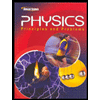 Glencoe Physics: Principles and Problems, Student...PhysicsISBN:9780078807213Author:Paul W. ZitzewitzPublisher:Glencoe/McGraw-Hill
Glencoe Physics: Principles and Problems, Student...PhysicsISBN:9780078807213Author:Paul W. ZitzewitzPublisher:Glencoe/McGraw-Hill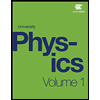 University Physics Volume 1PhysicsISBN:9781938168277Author:William Moebs, Samuel J. Ling, Jeff SannyPublisher:OpenStax - Rice University
University Physics Volume 1PhysicsISBN:9781938168277Author:William Moebs, Samuel J. Ling, Jeff SannyPublisher:OpenStax - Rice University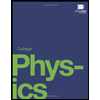 College PhysicsPhysicsISBN:9781938168000Author:Paul Peter Urone, Roger HinrichsPublisher:OpenStax College
College PhysicsPhysicsISBN:9781938168000Author:Paul Peter Urone, Roger HinrichsPublisher:OpenStax College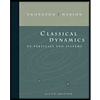 Classical Dynamics of Particles and SystemsPhysicsISBN:9780534408961Author:Stephen T. Thornton, Jerry B. MarionPublisher:Cengage Learning
Classical Dynamics of Particles and SystemsPhysicsISBN:9780534408961Author:Stephen T. Thornton, Jerry B. MarionPublisher:Cengage Learning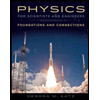 Physics for Scientists and Engineers: Foundations...PhysicsISBN:9781133939146Author:Katz, Debora M.Publisher:Cengage Learning
Physics for Scientists and Engineers: Foundations...PhysicsISBN:9781133939146Author:Katz, Debora M.Publisher:Cengage Learning Physics for Scientists and Engineers, Technology ...PhysicsISBN:9781305116399Author:Raymond A. Serway, John W. JewettPublisher:Cengage Learning
Physics for Scientists and Engineers, Technology ...PhysicsISBN:9781305116399Author:Raymond A. Serway, John W. JewettPublisher:Cengage Learning

Glencoe Physics: Principles and Problems, Student...
Physics
ISBN:9780078807213
Author:Paul W. Zitzewitz
Publisher:Glencoe/McGraw-Hill

University Physics Volume 1
Physics
ISBN:9781938168277
Author:William Moebs, Samuel J. Ling, Jeff Sanny
Publisher:OpenStax - Rice University

College Physics
Physics
ISBN:9781938168000
Author:Paul Peter Urone, Roger Hinrichs
Publisher:OpenStax College

Classical Dynamics of Particles and Systems
Physics
ISBN:9780534408961
Author:Stephen T. Thornton, Jerry B. Marion
Publisher:Cengage Learning

Physics for Scientists and Engineers: Foundations...
Physics
ISBN:9781133939146
Author:Katz, Debora M.
Publisher:Cengage Learning

Physics for Scientists and Engineers, Technology ...
Physics
ISBN:9781305116399
Author:Raymond A. Serway, John W. Jewett
Publisher:Cengage Learning
Newton's First Law of Motion: Mass and Inertia; Author: Professor Dave explains;https://www.youtube.com/watch?v=1XSyyjcEHo0;License: Standard YouTube License, CC-BY